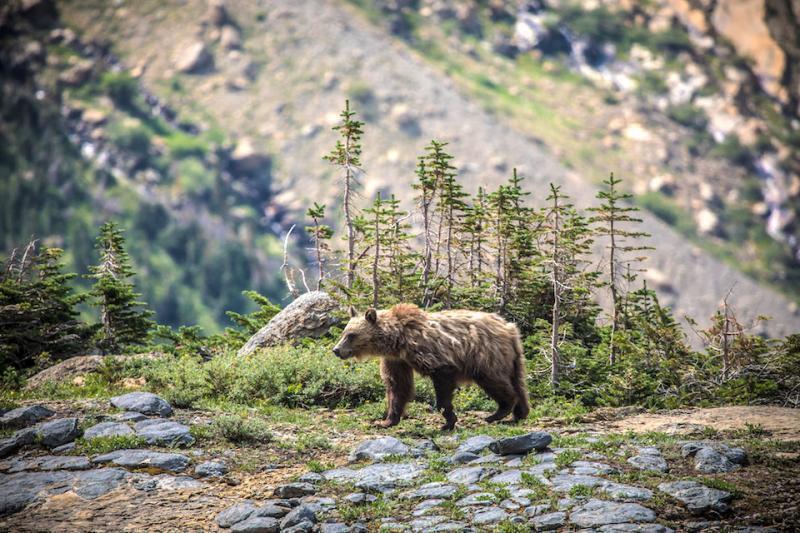
A lawsuit has been filed against BNSF Railway in connection with the deaths of grizzly bears killed by trains or "rail activities"/NPS file
Editor's note: This updates with a response from BNSF Railway.
A railroad that operates tracks near the core of grizzly recovery zones in Montana along the southern boundary of Glacier National Park and in Idaho was sued Thursday over the deaths of grizzly bears that often are drawn to the tracks by carrion or spilled grains.
Since 2008, an estimated 63 grizzlies, a threatened species under the Endangered Species Act, have been killed in collisions with trains near the Northern Continental Divide and Cabinet-Yaak grizzly bear recovery zones, according to the Western Environmental Law Center, Western Watersheds Project, and Wildlife Guardians. The grizzly deaths came during a years-long effort by BNSF Railway to develop a habitat conservation plan that would include mitigation measures and obtain an incidental take permit, the latter which would allow the deaths of a specific number of bears, they added.
The U.S. Fish and Wildlife Service has not yet issued a decision on BNSF’s request for an incidental take permit or its proposed HCP, the groups said.
“We are extremely disappointed that, after all these years, BNSF has refused to change its business practices to prevent the unnecessary deaths of Montana’s iconic grizzlies, resulting in the tragic deaths of three bears just this fall,” said Sarah McMillan, Wildlife and Wildlands Program director at the Western Environmental Law Center in Missoula, Montana. “When a company chooses to operate in the epicenter of key habitat for a threatened species, it must take some responsibility to adapt practices to minimize its impacts on these animals.”
BNSF operates 206 miles of railway in key grizzly habitat known as the Northern Continental Divide Ecosystem, crossing multiple national forests and along the southern border of Glacier National Park. Trains operated by BNSF or under its authority have killed or contributed to the deaths of approximately 52 grizzlies between 2008 and 2018, the groups said in a release, adding that trains on BNSF railways killed eight grizzly bears from the NCDE recovery zone in 2019 and three more in fall of 2023.
BNSF officials said Thursday evening that they were continuing to work with state and federal agencies to reduce the numbers of bears struck by trains.
"We have been working closely with the U.S. Fish & Wildlife Service, Montana Fish Wildlife and Parks, the U.S. Forest Service and the Blackfeet Nation to reduce grizzly bear mortalities since the 1990s. More recently, we have worked to develop a Habitat Conservation Plan and a draft HCP was published in January 2021," wrote Lena Kent, the railroad's general director for public affairs, in an email. "Hundreds of comments were received and the final HCP has been submitted to the U.S. Fish & Wildlife Service to be reviewed before it is published.
"The HCP memorializes many of the steps BNSF has already been taking to reduce grizzly bear deaths, including:
- Removal of spilled/leak grain and carrion from track structures
- Reducing/removing vegetation that might attract grizzly bears
- Funding for additional grizzly bear managers for Montana Fish Wildlife and Parks and the Blackfeet Nation
- Funding for radio collars, bear-proof garbage bins and electric fencing
- Funding for grizzly bear awareness programs
"BNSF’s goal is to reduce grizzly bear mortality and maintain compliance with the Endangered Species Act," said Kent.
But the conservation organizations maintain that the company’s proposed, long-delayed HCP fails to include any measures to change train operating schedules or speeds, which could prevent the deaths of threatened grizzlies from trains, and would allow BNSF to continue its operations as usual.
“The Burlington Northern railway runs right alongside Glacier National Park, some of the most prime grizzly habitat in the world, so the railway should be expected to slow down and take precautions to ensure grizzly bears aren’t put at risk from train operations,” said Erik Molvar of Western Watersheds Project. “With the addition of Montana Rail Link, BNSF now has additional responsibilities to protect grizzly bears in the Cabinet-Yaak ecosystem.”
“Burlington Northern Railway has been given carte blanche to run trains through core grizzly bear habitat for far too long,” added Lizzy Pennock, carnivore coexistence attorney at WildEarth Guardians. “Enough is enough. BNSF must be held responsible for the dozens of federally protected bears it has already killed, and for the dozens more it will predictably kill if the company refuses to change.”



Comments
Why can't we sue wind turbine developers, owners, and operators for the THOUSANDS of deaths of endangered and threatened species of birds?
I note that Wild Earth Gaurdiians have made no such effort to protect birds from wind turbines. According to WildEarth's IRS Form 990 (2022), they spent $530K to raise $4.3 million = 13%--a bit high for enviromentally-focused 501c3's.
Most glaring though is that of the $4,660,000 in revenue, $3,260,000 went to salaries & compensation = 70%, with a measley 30% for "defending wildlife". Where all this compensation is going is a mystery since therre's only 2 paid dircetors making very modest incomes. Attorneys?
Then there's another $5 million in reserves.
Chasing BNSF for grizzly deaths while millions of birds are dying seems be more like ambulance chasing,,..err, train chasing.
When I'm photographing grizzles I always make freight train noises so they don't notice me. Since if they are actually doing the mitigration stated the only answer is to shep Montana grain east instead of west.